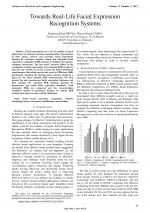| 2/2015 - 12 |
Towards Real-Life Facial Expression Recognition SystemsBENTA, K.-I. |
| Extra paper information in |
| Click to see author's profile in |
| Download PDF |
Author keywords
facial expression recognition, affective computing, feature extraction, classification, database
References keywords
recognition(74), facial(70), computing(20), pattern(19), emotion(16), analysis(15), automatic(14), affective(14), image(12), vision(10)
Blue keywords are present in both the references section and the paper title.
About this article
Date of Publication: 2015-05-31
Volume 15, Issue 2, Year 2015, On page(s): 93 - 102
ISSN: 1582-7445, e-ISSN: 1844-7600
Digital Object Identifier: 10.4316/AECE.2015.02012
Web of Science Accession Number: 000356808900012
SCOPUS ID: 84979726417
Abstract
Facial expressions are a set of symbols of great importance for human-to-human communication. Spontaneous in their nature, diverse and personal, facial expressions demand for real-time, complex, robust and adaptable facial expression recognition (FER) systems to facilitate the human-computer interaction. The last years' research efforts in the recognition of facial expressions are preparing FER systems to step into the real-life. In order to meet the before-mentioned requirements, this article surveys the work in FER since 2008, particularly adopting the discrete states emotion model in a quest for the most valuable FER works/systems. We first present the new spontaneous facial expression databases and then organize the real-time FER solutions grouped by spontaneous and posed facial expression databases. Then automatic FERs are compared and the cross-database validation method is presented. Finally, we outline FER system open issues to meet real-life challenges. |
| References | | | Cited By |
Web of Science® Times Cited: 13 [View]
View record in Web of Science® [View]
View Related Records® [View]
Updated 2 weeks, 4 days ago
SCOPUS® Times Cited: 14
View record in SCOPUS® [Free preview]
View citations in SCOPUS® [Free preview]
[1] Real-Time Facial Emotion Recognition Framework for Employees of Organizations Using Raspberry-Pi, Rathour, Navjot, Khanam, Zeba, Gehlot, Anita, Singh, Rajesh, Rashid, Mamoon, AlGhamdi, Ahmed Saeed, Alshamrani, Sultan S., Applied Sciences, ISSN 2076-3417, Issue 22, Volume 11, 2021.
Digital Object Identifier: 10.3390/app112210540 [CrossRef]
[2] Anatomization of the systems of dimension relaxation for facial recognition, Raha, Mayamin Hamid, Deb, Tonmoay, Rahmun, Mahieyin, Chen, Tim, Intelligent Decision Technologies, ISSN 1872-4981, Issue 4, Volume 14, 2021.
Digital Object Identifier: 10.3233/IDT-190120 [CrossRef]
[3] Mining Inconsistent Emotion Recognition Results With the Multidimensional Model, Landowska, Agnieszka, Zawadzka, Teresa, Zawadzki, Michal, IEEE Access, ISSN 2169-3536, Issue , 2022.
Digital Object Identifier: 10.1109/ACCESS.2021.3139078 [CrossRef]
[4] Software Architecture Design for Spatially-Indexed Media in Smart Environments, SCHIPOR, O.-A., WU, W., TSAI, W.-T., VATAVU, R.-D., Advances in Electrical and Computer Engineering, ISSN 1582-7445, Issue 2, Volume 17, 2017.
Digital Object Identifier: 10.4316/AECE.2017.02003 [CrossRef] [Full text]
[5] The current challenges of automatic recognition of facial expressions: A systematic review, Masson, Audrey, Cazenave, Guillaume, Trombini, Julien, Batt, Martine, AI Communications, ISSN 1875-8452, Issue 3-6, Volume 33, 2020.
Digital Object Identifier: 10.3233/AIC-200631 [CrossRef]
[6] SenseGraph: Affect Self-monitoring and Tagging Tool with Wearable Devices, Alpers, Sebastian, Benta, Kuderna-Iulian, 2021 International Conference on Computer Communications and Networks (ICCCN), ISBN 978-1-6654-1278-0, 2021.
Digital Object Identifier: 10.1109/ICCCN52240.2021.9522286 [CrossRef]
[7] The affinity platform, Ardelean, Alexandru, Benţa, Kuderna-Iulian, Adjunct Proceedings of the 2020 ACM International Joint Conference on Pervasive and Ubiquitous Computing and Proceedings of the 2020 ACM International Symposium on Wearable Computers, ISBN 9781450380768, 2020.
Digital Object Identifier: 10.1145/3410530.3414371 [CrossRef]
[8] Comparison of selected off-the-shelf solutions for emotion recognition based on facial expressions, Brodny, Grzegorz, Kolakowska, Agata, Landowska, Agnieszka, Szwoch, Mariusz, Szwoch, Wioleta, Wrobel, Michal R., 2016 9th International Conference on Human System Interactions (HSI), ISBN 978-1-5090-1729-4, 2016.
Digital Object Identifier: 10.1109/HSI.2016.7529664 [CrossRef]
[9] A multimodal affective monitoring tool for mobile learning, Benta, Kuderna-Iulian, Cremene, Marcel, Vaida, Mircea-Florin, 2015 14th RoEduNet International Conference - Networking in Education and Research (RoEduNet NER), ISBN 978-1-4673-8179-6, 2015.
Digital Object Identifier: 10.1109/RoEduNet.2015.7311824 [CrossRef]
Disclaimer: All information displayed above was retrieved by using remote connections to respective databases. For the best user experience, we update all data by using background processes, and use caches in order to reduce the load on the servers we retrieve the information from. As we have no control on the availability of the database servers and sometimes the Internet connectivity may be affected, we do not guarantee the information is correct or complete. For the most accurate data, please always consult the database sites directly. Some external links require authentication or an institutional subscription.
Web of Science® is a registered trademark of Clarivate Analytics, Scopus® is a registered trademark of Elsevier B.V., other product names, company names, brand names, trademarks and logos are the property of their respective owners.
Faculty of Electrical Engineering and Computer Science
Stefan cel Mare University of Suceava, Romania
All rights reserved: Advances in Electrical and Computer Engineering is a registered trademark of the Stefan cel Mare University of Suceava. No part of this publication may be reproduced, stored in a retrieval system, photocopied, recorded or archived, without the written permission from the Editor. When authors submit their papers for publication, they agree that the copyright for their article be transferred to the Faculty of Electrical Engineering and Computer Science, Stefan cel Mare University of Suceava, Romania, if and only if the articles are accepted for publication. The copyright covers the exclusive rights to reproduce and distribute the article, including reprints and translations.
Permission for other use: The copyright owner's consent does not extend to copying for general distribution, for promotion, for creating new works, or for resale. Specific written permission must be obtained from the Editor for such copying. Direct linking to files hosted on this website is strictly prohibited.
Disclaimer: Whilst every effort is made by the publishers and editorial board to see that no inaccurate or misleading data, opinions or statements appear in this journal, they wish to make it clear that all information and opinions formulated in the articles, as well as linguistic accuracy, are the sole responsibility of the author.



